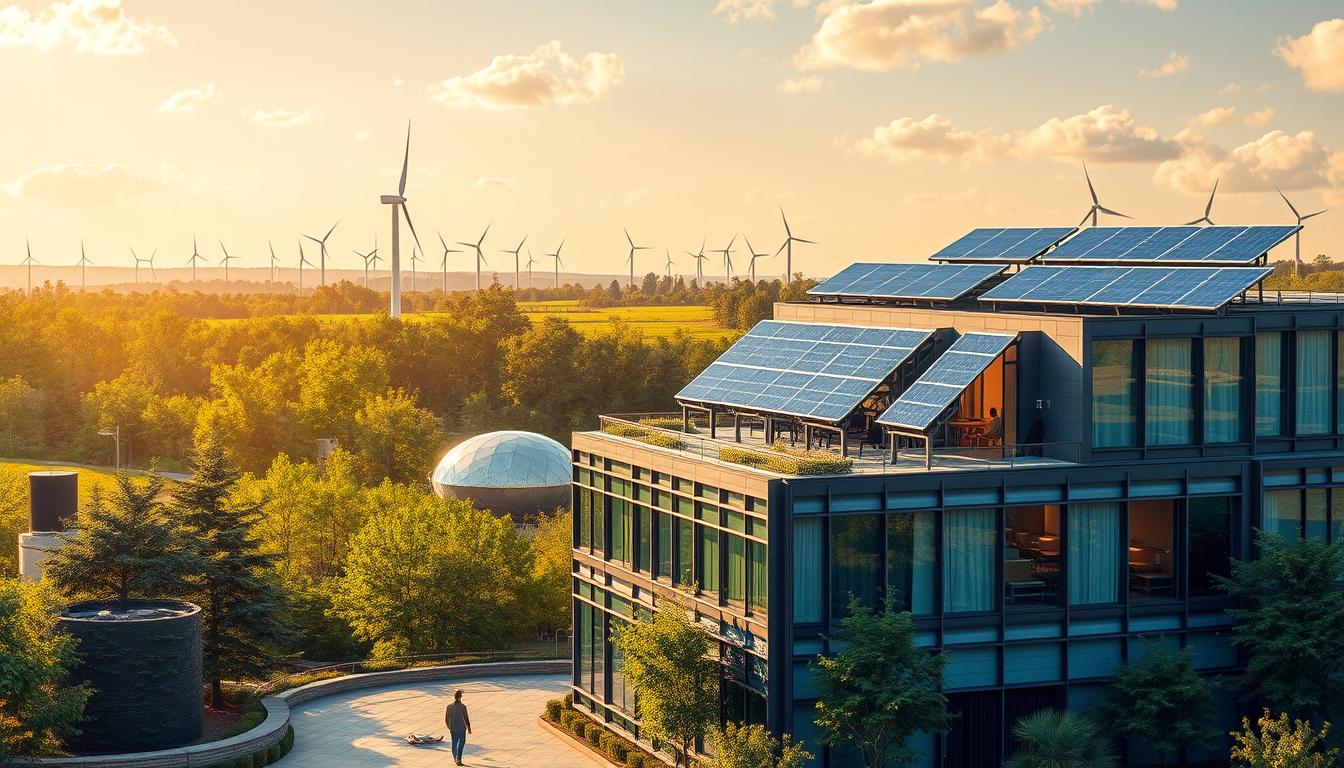The real estate sector is evolving rapidly as sustainability becomes a core focus for stakeholders. By 2025, new standards will reshape how buildings are operated, maintained, and valued. For professionals overseeing daily operations, understanding these shifts isn’t optional, it’s essential.
Environmental, social, and governance (ESG) principles now drive decisions across the industry. These criteria influence everything from energy use to tenant satisfaction. With over 70% of existing structures expected to remain in use until 2050, aligning with modern expectations ensures long-term viability.
Regulatory demands and investor priorities are tightening. Local governments and corporate tenants increasingly require proof of sustainable practices. This creates both challenges and opportunities for those managing physical assets day-to-day.
It’s important to clarify roles here. Property managers handle operational tasks like maintenance and tenant relations. Technical asset managers, meanwhile, focus on financial performance and long-term investment goals. Both must collaborate to meet ESG targets without overlapping responsibilities.
This guide will explore practical steps to adapt, including energy-efficient upgrades, navigating policy changes, and fostering teamwork across roles. Let’s dive into how proactive strategies today can secure success tomorrow.
Key Takeaways
- ESG principles are reshaping real estate priorities, with environmental, social, and governance factors now critical for long-term value.
- Buildings operational until 2050 must align with stricter sustainability standards driven by regulations and market demands.
- Property managers focus on daily operations, while asset managers prioritize financial outcomes—clear collaboration is key.
- Energy efficiency upgrades and data-driven strategies will play a central role in meeting 2025 compliance goals.
- Tenant expectations and investor criteria increasingly require transparent, measurable sustainability efforts.
Introduction to ESG in Property Management
The shift toward eco-friendly operations is transforming how buildings are managed today. Three pillars—environmental care, social responsibility, and ethical oversight—now guide decisions that affect both tenant well-being and long-term asset performance. These principles help teams balance immediate needs with future-proof strategies.
Environmental efforts focus on reducing energy use and waste. Social initiatives prioritize fair housing policies and community engagement. Governance ensures transparent decision-making and accountability. Together, these areas create measurable value for occupants and owners.
Tenants increasingly seek spaces that align with their values. Buildings with green certifications see 7% higher occupancy rates on average. Data tracking tools help teams monitor progress, from utility savings to tenant feedback. This information shapes upgrades that boost efficiency while cutting costs.
Investors now screen opportunities using sustainability metrics. Over 60% of commercial leases include clauses requiring eco-friendly practices. Staying ahead means adopting clear objectives now—before regulations tighten further. The next sections will explore actionable steps to meet these evolving standards.
Key ESG Factors Affecting Property Operations
Modern building operations are being redefined by data and environmental accountability. Three critical areas now determine success: resource efficiency, occupant health, and regulatory alignment. Teams must balance immediate costs with future-proof strategies to meet evolving standards.
Environmental priorities focus on measurable outcomes. Net-zero energy structures and LEED-certified facilities set benchmarks, using smart sensors to track water use and air quality. For example, recycled materials in renovations can reduce carbon footprints by up to 40%.
Social factors emphasize community impact and tenant well-being. Green leases now include clauses for waste reduction programs and accessibility upgrades. These efforts boost retention while aligning with tenant values.
- Governance transparency through digital reporting tools
- Real-time energy monitoring systems
- Local regulation audits for climate resilience
Risks range from outdated infrastructure penalties to shifting emissions laws. Data-driven analysis helps teams prioritize upgrades—like HVAC optimizations that cut costs while meeting 2025 efficiency targets. Proactive planning today prevents costly overhauls tomorrow.
Navigating Regulatory Changes for 2025
New rules for building operations will take effect in 2025, reshaping how teams track and report sustainability efforts. Governments worldwide are tightening standards for emissions tracking, energy benchmarks, and water usage limits. These updates aim to future-proof urban infrastructure while addressing climate concerns.
To stay ahead, teams must audit current practices against upcoming requirements. Digital tools that monitor energy patterns or waste outputs simplify this process. For example, automated systems can flag when a building nears carbon thresholds set by local laws.
Clear data collection remains critical. Regular reports showing progress toward targets help avoid penalties and build trust with tenants. Many cities now require annual disclosures on energy consumption and renovation plans.
Ignoring these shifts carries risks—from fines to losing eco-conscious occupants. Proactive teams align business objectives with regulatory timelines. This might mean upgrading HVAC systems early or partnering with sustainability consultants.
Adapting to these changes strengthens long-term viability in real estate. Transparent communication about upgrades also boosts tenant retention. Those who act now will navigate 2025’s landscape with confidence.
ESG compliance property management: Strategies for Success
Achieving sustainability targets requires practical steps tailored to daily operations. Start by conducting energy audits to identify waste patterns. Smart sensors tracking electricity usage often reveal quick wins, like adjusting HVAC schedules or sealing air leaks.
Upgrade lighting to LED systems and install low-flow water fixtures. These changes cut cost immediately while meeting efficiency standards. Pair these upgrades with tenant education programs—simple guides on reducing consumption foster collaboration.
Set clear benchmarks aligned with local regulations and investor priorities. Track progress quarterly using digital dashboards that show energy savings or carbon reductions. Transparent reporting builds trust and demonstrates measurable results.
Streamline workflows by integrating sustainability into routine tasks. For example, include waste diversion rates in maintenance checklists or prioritize eco-friendly vendors during renovations. Avoid blending these efforts with unrelated facility tasks to maintain focus.
Finally, engage stakeholders through regular updates. Share success stories in newsletters or host briefings on upcoming initiatives. This proactive approach turns compliance into a value-building tool for real estate portfolios.
Enhancing Asset Value and Tenant Experience
Buildings that prioritize sustainability are seeing measurable benefits in both market value and tenant loyalty. Simple upgrades like LED lighting and smart thermostats cut energy bills while improving comfort. These changes create environments where people want to live and work longer.
Tenant satisfaction surveys show occupants prefer spaces with natural light and clean air systems. Properties with high indoor air quality scores report 18% faster lease renewals. This directly impacts asset worth—green-certified buildings command 5-10% higher rents than comparable properties.
Water-efficient fixtures and drought-resistant landscaping reduce water use by up to 15%. These savings lower operating costs, making the building more attractive to investors. Facility teams handle maintenance of these systems, while property managers focus on communicating benefits to occupants.
Key differences matter here. Property management tracks overall performance metrics and tenant feedback. Facility management ensures physical systems operate efficiently. Clear collaboration between these roles prevents overlaps and maximizes value.
Regular updates about sustainability efforts—like sharing monthly energy savings in newsletters—build trust with tenants. When occupants see their well-being prioritized, they become partners in maintaining the property’s long-term appeal.
Data-Driven Insights for Sustainable Operations
Accurate information fuels smarter decisions in modern building maintenance. Tracking energy patterns, water use, and waste outputs reveals where improvements matter most. Teams that analyze this data consistently achieve 20% faster progress toward sustainability goals compared to those relying on guesswork.
Regular monitoring turns raw numbers into actionable strategies. For example, weekly reports might show peak electricity demand occurs during off-hours due to outdated HVAC settings. Adjusting these timings could cut costs while reducing carbon footprints.
Transparency builds trust with tenants and investors. Sharing quarterly performance dashboards demonstrates measurable progress—like a 15% drop in water usage after installing smart irrigation systems. This openness encourages collaboration and highlights areas needing attention.
Training staff to interpret metrics ensures everyone contributes to long-term objectives. Workshops on interpreting energy reports or setting achievable targets create a culture of continuous improvement. Teams learn to spot trends early, like gradual increases in heating costs signaling insulation issues.
Aligning daily operations with clear sustainability goals prevents wasted effort. Prioritizing upgrades based on data—such as replacing high-energy lighting first—maximizes impact. This approach keeps projects on budget while meeting evolving standards in real estate.
Implementing Energy and Water Efficiency Measures
Practical upgrades can transform how buildings use resources while cutting costs. Start with smart energy systems that automate lighting and HVAC schedules based on occupancy. These tools reduce waste without sacrificing comfort—think motion-activated lights in common areas or thermostats that adjust during off-hours.
Upgrade to LED lighting and improve insulation in walls and windows. These changes lower monthly bills and extend equipment lifespan. For water conservation, install low-flow showerheads and dual-flush toilets. Landscaping with native plants reduces irrigation needs by up to 50% in dry climates.
Modern data tracking systems help teams monitor progress. Dashboards showing real-time energy use or water consumption highlight inefficiencies quickly. For example, spotting a spike in midnight electricity usage might reveal outdated equipment running unnecessarily.
These strategies boost efficiency ratings while shrinking carbon footprints. Buildings with visible upgrades—like solar panels or rainwater collection features—attract eco-conscious tenants. Investors increasingly favor real estate projects that pair cost savings with measurable sustainability wins.
Regular maintenance ensures systems perform optimally. Schedule annual checks for leaks, insulation gaps, or sensor calibration. Small fixes today prevent bigger expenses tomorrow, keeping operations aligned with long-term goals.
Collaborative Management: Roles of Technical Property and Asset Managers
Strong partnerships between specialized teams ensure buildings meet modern standards while delivering value. Property managers focus on daily operations—handling tenant requests, maintenance schedules, and safety protocols. Asset managers prioritize financial outcomes, analyzing market trends and investment returns. Clear role definitions prevent overlaps and streamline decision-making.
Transparency bridges these roles. Regular reports showing utility savings or occupancy rates build trust with owners. For example, shared dashboards track progress toward shared goals like reducing energy waste by 15% annually. This alignment turns data into actionable insights for both teams.
| Property Managers | Asset Managers |
|---|---|
| Oversee tenant relations | Evaluate portfolio performance |
| Manage repair budgets | Plan long-term upgrades |
| Implement safety protocols | Analyze market risks |
Collaborative initiatives drive success. Joint meetings align maintenance plans with renovation timelines. Shared KPIs ensure upgrades like solar installations meet both operational and financial objectives.
Modern solutions like cloud-based platforms keep teams synchronized. These tools automate updates about lease renewals or equipment warranties. When roles stay distinct but connected, properties thrive in competitive real estate markets.
Building a Culture of ESG Training and Continuous Improvement
Empowering teams with knowledge creates lasting change in how buildings operate. Regular workshops on energy efficiency and waste reduction keep staff updated on evolving best practices. This approach turns temporary fixes into ingrained habits that benefit tenants and owners alike.
Effective onboarding sets the tone. New hires receive modules explaining certifications like LEED or ENERGY STAR. They shadow experienced colleagues to learn how daily tasks connect to broader sustainability goals. This builds a shared understanding from day one.
Ongoing education drives measurable results. A manager in Chicago reduced utility costs by 12% after quarterly sessions on smart thermostat optimization. Tenants noticed consistent temperatures and clearer air quality reports—key factors in lease renewals.
Simple tracking systems maintain momentum. Digital dashboards show progress toward targets like water conservation or recycling rates. Teams celebrate milestones through internal newsletters, reinforcing the value of their efforts.
Long-term benefits extend beyond operations. Buildings with trained staff attract investors seeking transparent, future-ready assets. When everyone understands their role in ESG initiatives, properties gain competitive features that stand out in crowded markets.
Conclusion
As 2025 approaches, aligning daily practices with sustainable standards becomes non-negotiable for those overseeing physical assets. Teams that leverage data insights and clarify roles between operational and financial experts will thrive. The strategies discussed—from energy retrofits to staff training—create measurable value while addressing regulatory risks.
Adopting these solutions strengthens transparency with tenants and investors, boosting confidence in real estate portfolios. Improved operations reduce costs and enhance esg performance, making properties more resilient to market shifts.
Proactive business leaders should start now. Audit current practices, set clear benchmarks, and foster collaboration across teams. Continuous improvement in esg practices isn’t just about meeting rules—it’s about building spaces people trust and value for decades.
FAQ
How can energy efficiency upgrades benefit my building’s performance?
Upgrading systems like HVAC, lighting, and insulation reduces operational costs while lowering carbon footprints. Many tenants prioritize eco-friendly spaces, which can boost retention and attract sustainability-focused businesses. Certifications like LEED or ENERGY STAR also enhance marketability.
What role do asset managers play in meeting sustainability goals?
Asset managers align investor objectives with on-site practices, ensuring upgrades like solar panels or water recycling systems deliver long-term value. They also track metrics to prove ROI, which is critical for securing funding and maintaining investor confidence.
Are there tools to simplify tracking water and energy usage?
Yes! Platforms like Energy Star Portfolio Manager and IoT-enabled sensors provide real-time insights into consumption patterns. These tools help identify leaks, optimize resource use, and generate reports for regulatory compliance or tenant transparency.
How do tenant preferences influence sustainable upgrades?
Modern renters and businesses increasingly demand green features, such as EV charging stations or low-flow fixtures. Meeting these expectations improves satisfaction, reduces vacancy rates, and can justify premium pricing for eco-conscious amenities.
What certifications should I prioritize for 2025 compliance?
Focus on globally recognized standards like BREEAM, GRESB, or WELL Building Certification. These not only future-proof operations against tightening regulations but also strengthen partnerships with investors who prioritize verified sustainability efforts.
Can small changes really impact a building’s environmental footprint?
Absolutely. Switching to LED lighting, installing smart thermostats, or adopting drought-resistant landscaping reduces waste and costs. Even minor adjustments, when scaled across portfolios, contribute significantly to broader climate goals.
How do I start fostering a culture of continuous improvement?
Begin with regular staff training on best practices and emerging technologies. Encourage feedback loops between technical teams and tenants to identify inefficiencies. Celebrate milestones, like reduced energy usage, to keep stakeholders engaged.







